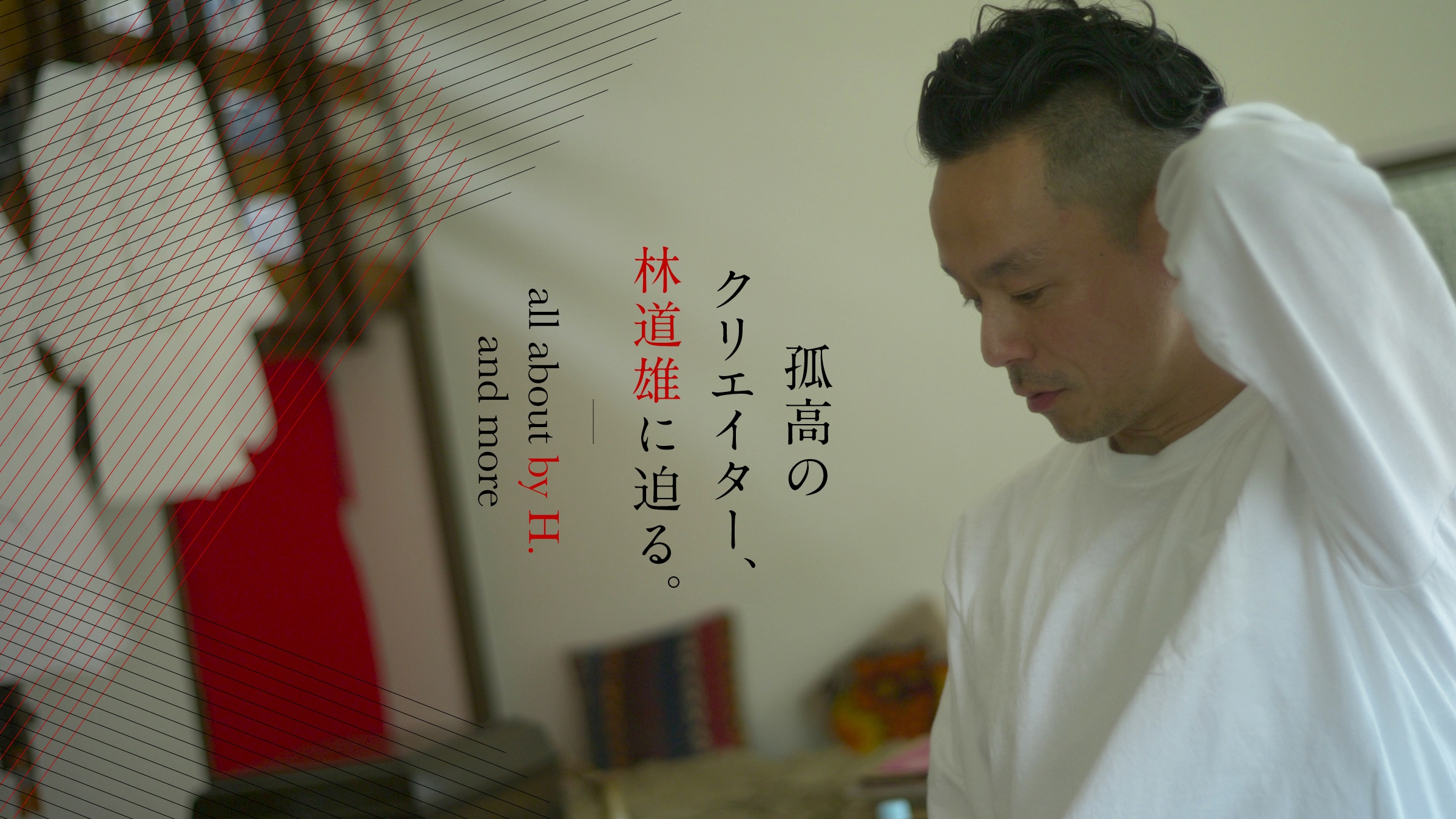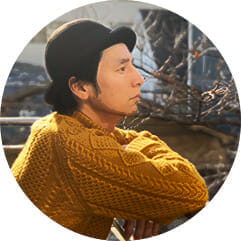PROFILE
. stylist and designer for <by H. Studied under Sonia Park and became independent in 2010. She started her own fashion brand "by H." in the 2020 SS season.
I don't think I've done this kind of interview before, but since we're here today, I'd like to hear all about it. By the way, this house is very interesting*. . To put it simply, I guess you could say it is a blend of Japanese and Western styles. (*The interview was conducted at Mr. Hayashi's home.)
Forest: Yes, it is. It's a typical Japanese-Western blend.
How do you acquire this kind of sense of style? Today, I would like to hear not only about "by H.", but also about the base of Hayashi's work.

The table in front of the kitchen is where he works. The homemade dining light is an eye-catching feature.
Forest: The Western part of the Japanese-Western blend is completely based on movies. I saw my first movie in a movie theater when I was in the second grade of elementary school, and I think the influence of the Hollywood movies I saw around that time is the standard for the Western part. It was roughly 1983-5 or so.
You like movies anyway, don't you?
Forest: Yes . I have been watching films of no genre for a long time, and it is only in the last few years that I have become acutely aware of the merits of Yasujiro Ozu, and I think that, worst of all, I could get by with only Ozu. . I can't stop talking about Ozu, so I'll stop now.

Forest: By the way, these symbols in " by H." are actually the aspect ratio of the movie. From right to left: "Standard," "European Vista," and "American Vista.
I see. So it's the angle of view of the movie.
Forest: Yes, I think so. Ozu's films were basically standard, and I think Godard's were also rather standard. When you are used to Vista size, wow! The width is too narrow! It's not that easy. Nowadays, IMAX is almost always standard size, isn't it? . Unfortunately, there are no theaters in Japan where IMAX can be seen in the true sense of the word. When I created the logo, the name "by H." had not yet been decided, but I wanted to use something I liked as a mark or a monument, so I decided on "movies. . However, I don't often make clothes with a movie theme.

The toile, of course, but also the mirror behind it, "Fashionable Shoes Tamaya," is a sight to behold.
Indeed. . But some items have their own unique names. If you look closely at this toile, you will see SHIRT-TM. If you have a chance, please ask Mr. Hayashi what this TM is. . And now, let's talk about the Japanese-Western blending.
Forest: Yes . I don't know myself, but I'm sure it is. . The choice of this property, the kitchen, and so on. However, what I am making is not so much Japanese style. It's not that I don't like Japanese taste, but in my case, my final destination is Western-style clothing. This is probably due to the influence of movies I saw in elementary school and my love of punk in elementary and junior high school.
What do you mean?
Forest: I was influenced by such white culture when I was most impressionable, and I think that's why I can't get rid of it to this day. I mean, I feel like it will never go away. For example, if I had listened to black music when I was impressionable, I might not be like this, because between the ages of 10 and 14, I happened to become obsessed with Hollywood movies and white culture like punk, so I think it's an influence from that.
You didn't think of making a career out of a movie you loved so much.
Forest: I didn't think of it at all. . it was more that I wanted to keep movies only for entertainment. If I made film my career, I might not be able to go to the cinema for a term or something, and I wouldn't be able to go to the cinema, and I wouldn't feel comfortable.
There is a saying that you should work at what you love second best , isn't there?
Forest: I'm sorry to keep talking about movies, but maybe I didn't want to work on a movie I liked after all. I wanted to keep my distance. If I started making clothes now, and then started making movies, I think I would be stuck. I would never make a film (laughs).

A hanger of his own making. Every detail is elaborate.
What were you wearing when you first got into fashion?
Forest: Punk. I was dressed "the" way. I wore rubber soles, tight-fitting 606s, long, loose-fitting T-shirts, and riders.
I see. It's rather straightforward punk.
Forest: . yes, so I guess that's why I get that when I design. I'm not conscious of it. I bought those clothes at a local punk store, and I can't get rid of that.
By the way, when did you start making clothes?
Forest: I was 26 years old when I left Bunka Fashion College. I had been working for a company for 5 years after graduating from high school. The salary at that company was quite good, but I decided that I was not suited for a salary job and decided to study something I liked, so I entered Bunka (Bunka Fashion College).
I see. I didn't know you were a businessman.
Forest: . I studied ladies' fashion all through my studies in culture. At that time, there was a famous brand that I wanted to work for anyway, but I failed. I thought I would definitely get the job (laughs). (Laughs.) I decided to quit the ladies' wear business for a while, because I couldn't wear the clothes myself after all, and I thought I might have to get my feet on the ground and work in the men's wear business. So I started men's wear in the last six months of my three years of school. From that point on, I have always been in men's wear.
What was your major in culture?
Forest: Apparel Design Department.

You are drawing your own patterns now, but did you also study men's pattern making in your culture?
Forest: I only did basic men's patternmaking. I was mainly working with ladies' wear, including 3D cutting. After graduating from Bunka Gakuin, I joined a men's maker. Since there was a small number of workers there, I was in a position where I had to draw patterns, and that's when I started working seriously. So I think I am almost self-taught in men's patternmaking.
So you are learning while you are working, out of necessity.
Forest: Yes, that's true. But I think that in a sense, people can think better when they are in dire straits, and they can absorb more things. I ended up working for that manufacturer for five years. Now I think those five years were very valuable. Without those five years, I would not be where I am today.

You've been here for quite a long time. I've been a businessman for 5 years.
Forest: Yes . I do it right unexpectedly (laughs). I guess you have to do everything for a certain number of years to see it, or maybe I'm just insensitive (laughs). (Laughs.) Then, my mentor, Sonia Park, happened to come to the brand to lease it. And I happened to be the one who served them. I talked to her and found her to be a very interesting person. To tell you the truth, I didn't really know Sonia Park at the time. I knew her name at least.
So you've heard about Arts & Science?
Forest: I knew the name of the store, but I had never been there. However, there was a store in Daikanyama at the time, but I had never been there. The place where I worked was also in Daikanyama (laugh). (laugh). For some reason, they were interested in me, and they said, "Why don't you become a stylist? He said, "Why don't you become a stylist? I think he was joking, but I don't know now (laughs). (Laughs.) That was the first time I asked myself what kind of work a stylist does. (laughs).









